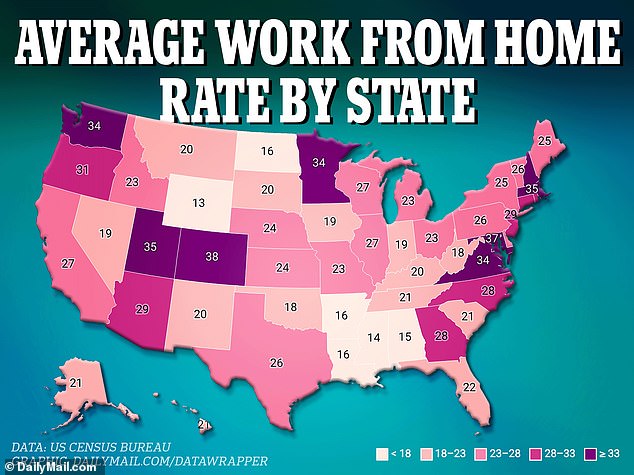Are these America’s laziest states? Map reveals areas with highest work-from-home rates
Are these the laziest states in America? The map shows areas with the highest rates for working from home
- Many companies have restricted remote working since the pandemic
- Although overall figures have fallen, working from home is still common
- Wyoming is the state with the lowest work-from-home rate in the US
Data shows that Colorado has the highest percentage of people still working from home of any U.S. state.
Since the rise of working from home during the pandemic, many companies have scrambled to get employees back into the office.
Overall, the pressure seems to be working. According to the latter two, about 26 percent of households have someone who works remotely at least one day a week Census Bureau Household Pulse Surveys.
This is a sharp decline from the early 2021 peak of 37 percent, data from Bloombergindependently verified by DailyMail.com.
But there’s still a big discrepancy between states: Colorado comes in first, with 38.3 percent of households reporting someone working from home at least once a week.

According to data from the US Census Bureau, Colorado is the state with the highest percentage of people still working from home
In the US, seven states – and Washington DC – have a homework rate of more than 33 percent.
Maryland has the second-highest percentage of households where someone worked from home at least one day in the past seven days: 36.9 percent.
About 34.9 percent of households in Utah have someone working remotely, 34.7 percent in Massachusetts and 34.3 percent in Minnesota.
On the other end of the spectrum, Wyoming employees are the least likely to work from home.
Only 12.9 percent of households had someone working from home in the past week in the state – where key industries include mining, agriculture and manufacturing.
Mississippi has the second-lowest percentage of remote workers at 13.5 percent, followed by Alabama at 14.8 percent, North Dakota at 16 percent and Arkansas at 16.2 percent.
States like Mississippi and Louisiana – where 16 percent are working from home – have not been as able to widely embrace remote work due to their reliance on personal industries, including manufacturing and the oil and gas industry.

Since the rise of working from home during the pandemic, many companies have scrambled to get employees back into the office
The declining numbers of people working from home reflect the continued pressure from companies to get staff back into the office.
Remote workers are blamed for declining profits and vacant “zombie workplaces” in some of the country’s largest cities.
Companies like Goldman Sachs and
Elon Musk has called working from home “morally wrong,” while Frontier Airlines CEO Barry Biffle said it makes people “lazy.”
“We have become lazy in Covid. I mean seriously, people are still allowing people to work from home, all this silliness, right? That’s all out the window. So we need to get people back into the office,” he said last month.
Although the overall number of remote workers is decreasing, it is still widespread.
Separate research has found that nearly a third of workdays in the US are spent at home.
In December last year, 29 percent of workdays took place from home, according to data from WFH Research, which rose slightly to 31 percent in July this year.
